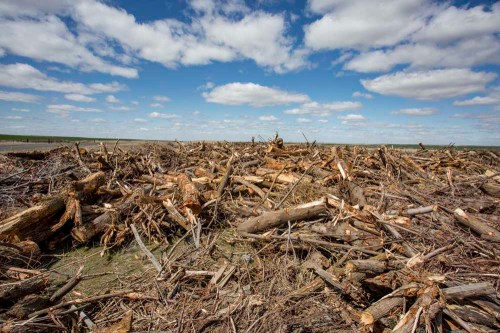Flood recovery is still a work in progress
Published 6:00 am Saturday, April 4, 2020

- A pile of debris from February’s Umatilla River flooding sits in a field near the Eastern Oregon Regional Airport in Pendleton on April 3, 2020.
PENDLETON — The February floods were the biggest disaster of 2020 before a worldwide pandemic arrived the following month and usurped it.
Despite the recent focus on preventing the spread of COVID-19, local officials are still working on repairing the damage from the widespread flooding across Umatilla County.
Trending
The Pendleton area was hit particularly hard by the floods, and the city government is set to join an intergovernmental agreement with the county and the Umatilla River Control District to secure funding for a critical levee repair.
The Pendleton Zone 2 levee stretches from the Interstate 84 overpass to Birch Creek, and when rapidly melting snow runoff overwhelmed the Umatilla River, the floodwaters breached the levee and flooded manufacturing facilities for Keystone RV Co. and Cor-Tek.
Worried the area would be reflooded by a spring high water event, the city authorized repairs almost immediately after the flood receded with the hope that the state would backfill the $1.8 million price tag.
As a condition of the funding Pendleton received for its repairs to the Zone 2 levee, which is owned and maintained by the Umatilla River Water Control District No. 1, the city, the district and Umatilla County were required by the state to ensure each entity is maintaining the levee for the next 10 years. To meet this requirement, an intergovernmental agreement was drafted and the Umatilla County Board of Commissioners approved entering that agreement on Wednesday. The Pendleton City Council will vote on the agreement at a meeting on Tuesday.
With debris mostly removed and stockpiled near the airport and the levee repaired, Public Works Director Bob Patterson said the work is pretty much done.
Patterson said the city’s long-term goal is to qualify Zone 2 for the U.S. Army Corps of Engineers’ Rehabilitation and Inspection Program, which provides federal funding to flood-damaged levees.
Trending
Zone 2 isn’t currently eligible because it wasn’t maintained to the Corps’ standards, and Jeffrey Henon, the spokesman for the Corps’ Portland District, said the inspection to add it into the program would look at more than the levee repairs.
“It’s not just the spot repairs,” he said. “We have to reassess the whole levee.”
The damage to the Pendleton Zone 1 levy, which encompasses the Pendleton River Parkway, was more minor, affecting mostly a gauge station and a seep-through point behind the East Oregonian office.
Zone 1 is a part of the Corps’ rehabilitation program, and Henon said the Corps would soon conduct a damage assessment of the levee.
The only other levee in the Portland District’s jurisdiction is the Gray Davis levee, a Mission dike that runs from Highway 331 to just beyond Williams Lane.
Jack Simons, a board member for the Riverside-Mission Water Control District and a Mission resident whose property intersects with the levee, said the Umatilla River overtopped the levee during the floods, damaging homes and overwhelming some nearby ponds.
Simons said the district was in contact with the Corps on assisting in surveying the levee for eventual repair, but correspondence was slow enough that the district moved forward and contracted with Pendleton Ready Mix to survey the dike and then heighten it to prevent future flooding.
All the local governments still recovering from February’s floods got to finally breath a sigh of relief on Friday evening when President Donald Trump officially issued a major disaster declaration.
Thanks to the declaration, Umatilla, Union and Wallowa counties and the Confederated Tribes of the Umatilla Indian Reservation are eligible for reimbursement through the Federal Emergency Management Administration for any repairs needed due to the floods.
The declaration also opens up individual financial assistance from FEMA for Umatilla County and CTUIR residents who had homes damaged in the floods.
Housing help
The February floods didn’t just damage dikes, but also destroyed Pendleton homes, especially in the Riverside neighborhood.
As a part of the state’s flood relief package, Oregon allocated $7.5 million to help displaced residents find new homes.
The Community Action Program of East Central Oregon has been working with the state to help spend the money.
CAPECO CEO Paula Hall said the housing assistance is divided into three pots: $4 million for a mobile home replacement program, $2 million for affordable housing and $1.5 million for rapid rehousing.
While the first two are for more long-term projects, Hall said the latter fund can be used right away, although it still has its limits.
While CAPECO has helped provide some insulation so some mobile home residents can reconnect their utilities, Hall said the rapid rehousing funds are supposed to be used to help flood victims find new rentals rather than mobile home repairs.
CAPECO was hoping to use some of the long-term money to purchase the largest mobile home park in the Riverside area and turn it into an affordable housing community. Declining to identify the specific park, Hall said the property owner declined CAPECO”s offer.
Hall said CAPECO is moving on and working with the city to identify future affordable housing projects, but the state money wouldn’t be able to alleviate all of the pain caused by the flooding.
“We cannot make everyone whole,” she said. “We are not a mini version of FEMA.”









